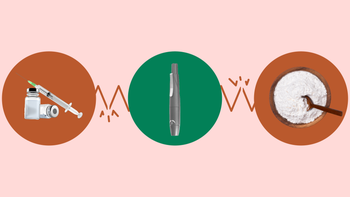
How Do You Treat Psoriatic Arthritis?
Key takeaways:
Psoriatic arthritis (PsA) is an autoimmune condition. It’s treated with immunosuppressants, medications that turn off a piece of the immune system.
There’s no “best” treatment for PsA. But with so many options to choose from, you and a healthcare professional can personalize treatment to best fit your needs.
Treatment of PsA can clear your skin, improve joint pain, and protect your body from permanent damage.
Psoriatic arthritis (PsA) is an autoimmune condition that involves inflammation of the skin and nails (like the condition psoriasis). But it also affects the joints, tendons, and spine. There’s no cure for PsA, but luckily there are many medications to treat it.
Treatment of PsA requires immunosuppressive medications (immunosuppressants) to turn off inflammation. There are many different types of these medications. Here, we’ll review these types and how they fit into the overall goals of PsA treatment.
What causes psoriatic arthritis?
Like most autoimmune conditions, we don’t exactly know what causes PsA. But we do know that the cause of PsA is a combination of things coming together in a perfect storm.
For example, certain genes might make you more likely to develop PsA than someone else. Then, some kind of environmental trigger wakes up the immune system and confuses it. Examples of these triggers are an infection, stressful accident, or toxin. The result is that the immune system starts attacking your own body instead, like a runaway train.
Is there a cure for psoriatic arthritis?
There’s no cure for PsA, but we do have many medication options to treat it. With the help of these medications, it’s possible to control your PsA symptoms and protect your body from permanent damage.
Medications for psoriatic arthritis
Immunosuppressants are medications that turn off a piece of the immune system in order to decrease inflammation. An overactive immune system causes inflammation in PsA. So it makes sense that medications to treat it turn off a part of the immune system.
Oral medications are an effective treatment for psoriatic arthritis (PsA). Learn more about your treatment options.
Your diet has an effect on PsA symptoms. Find out how what you eat can affect PsA flares.
Is it possible to prevent PsA flares? Here are some triggers you need to know to prevent worsening symptoms.
Immunosuppressants come in all different forms — pills, injections, and infusions. They fit into three general categories:
Below, we go into each category in more detail.
1. Disease-modifying antirheumatic drugs
DMARDs are medications that you take by mouth. They treat mild to moderate PsA. You may combine them with biologic or small molecule medications for more severe cases.
DMARDs typically take at least 6 to 8 weeks to start working, with full effect around 3 to 6 months. Current guidelines suggest that biologics might be a better first-choice treatment for some people. But there are situations when starting with a DMARD could make sense too. We’ll review more on how to choose below.
DMARDs for PsA include:
Methotrexate: the most commonly used DMARD since it’s cheap and effective for skin and joint symptoms
Sulfasalazine: a good option for people who are pregnant or trying to conceive
Leflunomide: works well for people who had side effects with methotrexate
Cyclosporine: isn’t used very frequently due to possible risky side effects
2. Biologics
When PsA is severe or fails to get better with DMARDs alone, biologics help control disease activity. Several different types of biologic medications are available to treat PsA. They each turn off a different piece of the immune system.
Biologics are injected or infused into the vein. They take about 3 to 6 months to kick in.
Biologic medications for psoriatic arthritis include:
TNF-alpha blockers, like adalimumab (Humira) and etanercept (Enbrel); when using biologics, current guidelines suggest using these first
IL-17 blockers, like secukinumab (Cosentyx) or ixekizumab (Taltz)
IL-12/23 and IL-23 blockers, like ustekinumab (Stelara) or guselkumab (Tremfya)
CTLA-4 blockers, like abatacept (Orencia)
3. Small molecules
Small molecules are another type of oral medication for PsA treatment. You can also use them in combination with DMARDs. These take about 6 to 8 weeks to kick in.
Small molecules to treat PsA include:
Janus kinase inhibitors: Examples are tofacitinib (Xeljanz) and upadacitinib (Rinvoq). Current guidelines and the FDA recommend considering these only if a TNF-alpha blocker biologic didn’t work or can’t be used.
PDE4 inhibitors: An example is apremilast (Otezla). Current guidelines recommend adding Otezla to a DMARD if needed, as opposed to using it by itself.
How do you choose a treatment for psoriatic arthritis?
There’s no single “best” treatment for PsA, since everyone’s symptoms are different. The goal is to find a treatment regimen that results in clear skin, happy joints, and better quality of life.
With so many options, it’s normal to feel a bit overwhelmed. But the flip side is that lots of treatment options means the ability to personalize treatment just for you.
Some factors that you and a healthcare professional will consider when choosing a medication include:
What parts of your body PsA affects
Severity of your symptoms
Other health conditions and medications
Medication side effects
Insurance coverage
If you don’t have insurance, or your insurance doesn’t cover the medication you need, there are programs out there to help. You may have to try a few different medications, or a combination of medications, before you find what works for you. But with a little patience and persistence, relief is possible.
At-home treatments for psoriatic arthritis
The best thing you can do to control your PsA is take your medications as your prescriber directs. Other things you can do on your own to feel better sooner include:
Eat a balanced diet. A comfortable weight helps take pressure off of your joints.
Exercise as you’re able. Movement helps protect the flexibility and mobility of joints.
Focus on self-care. Getting enough sleep and keeping stress at bay can help prevent PsA flares (when symptoms temporarily worsen).
Stop smoking. Smoking can make psoriasis and PsA worse.
Lean on your support system. An arthritis support group can also be a great resource.
What dietary changes can help with psoriatic arthritis?
There are no specific foods to eat or avoid if you have PsA. But a nutritious diet will help you maintain your weight and decrease your risk of heart disease. PsA increases heart disease risk due to inflammation, so a balanced diet is a win-win approach.
Of note, certain foods or drinks may cause psoriasis flares in some people. If that’s true for you, it’s a good idea to avoid those if you have PsA.
What happens if you don’t treat psoriatic arthritis?
If left untreated, PsA can cause permanent joint damage and skin changes. When inflammation is severe, the eyes, heart, and bowel are also at risk for complications. Working with a healthcare professional to find medications that work for you is the best thing you can do to protect yourself.
Frequently asked questions
People with PsA get joint pain and swelling in addition to the psoriasis rashes. The joints most commonly affected are the tips of the fingers and the toes. It’s common to get pain in the areas where tendons join the bones, especially at the back of the heels and elbows. People with PsA may also feel:
Back pain
Fatigue
Swelling of the fingers
Eye inflammation
Nail changes
Treatment of PsA related pain will depend on how severe the symptoms are and the area of the body that’s affected.
For short-term relief of pain, options include:
Nonsteroidal anti-inflammatories (NSAIDs)
Joint injections
Steroids
For long-term treatment, several options may help control the disease process over the long term. This may, as a result, help improve pain. Examples of these medications are:
Immunosuppressants such as DMARDs
Biologics
Small molecules
Other treatments can help relieve pain along with medication. These include low-impact exercises such as:
Swimming
Physical therapy
Weight loss
Massage therapy
To manage PsA symptoms, options include short-term over-the-counter (OTC) pain medication such as ibuprofen or naproxen. Also, an occasional steroid injection into the joint can help. These are generally considered to be safe.
But these medications might not be the best option in these cases:
Long-term control of symptoms
Controlling disease activity
Treating more severe disease
A healthcare professional can help determine which medication for PsA is most suitable and safe for you.
The bottom line
PsA is a lifelong but highly treatable condition. With so many different treatment options, there’s a regimen out there that can work for you. Taking your medication is the best way to prevent damage from PsA, but healthy lifestyle changes can also help.
Why trust our experts?



References
American College of Rheumatology. (n.d.). Psoriatic arthritis guideline.
Arthritis Foundation. (n.d.). About arthritis.
Arthritis Foundation. (2022). Psoriatic arthritis and your heart.
Benjamin, O., et al. (2023). Disease-modifying antirheumatic drugs (DMARD). StatPearls.
Engel, K. (2021). Exercising with psoriatic arthritis: How to get started and work out safely. CreakyJoints.
Orenstein, B. W. (2021). Smoking and psoriasis. National Psoriasis Foundation.
Veale, D. J., et al. (2018). The pathogenesis of psoriatic arthritis. The Lancet.
Watson, S. (2022). Treatment options for psoriatic arthritis. Arthritis Foundation.

























